Financial Accounting Report: Intangible Assets for ACC701, KOI
VerifiedAdded on 2022/11/17
|12
|2805
|191
Report
AI Summary
This report provides an analysis of financial accounting practices, particularly focusing on intangible assets. It examines the application of accounting standards AASB 138 and IAS 38 within the context of a case study involving Technology Enterprise Ltd. The report explores the valuation of intangible assets, the treatment of research and development costs, and the impact of these factors on a company's financial statements. It emphasizes the importance of adhering to accounting standards for accurate financial reporting and comparability. The report also discusses the recognition and measurement of intangible assets, including the present value approach and fair value considerations. Finally, it addresses the reduction of comparability in financial statements and provides an understanding of the key principles outlined in AASB 138 and IAS 38.
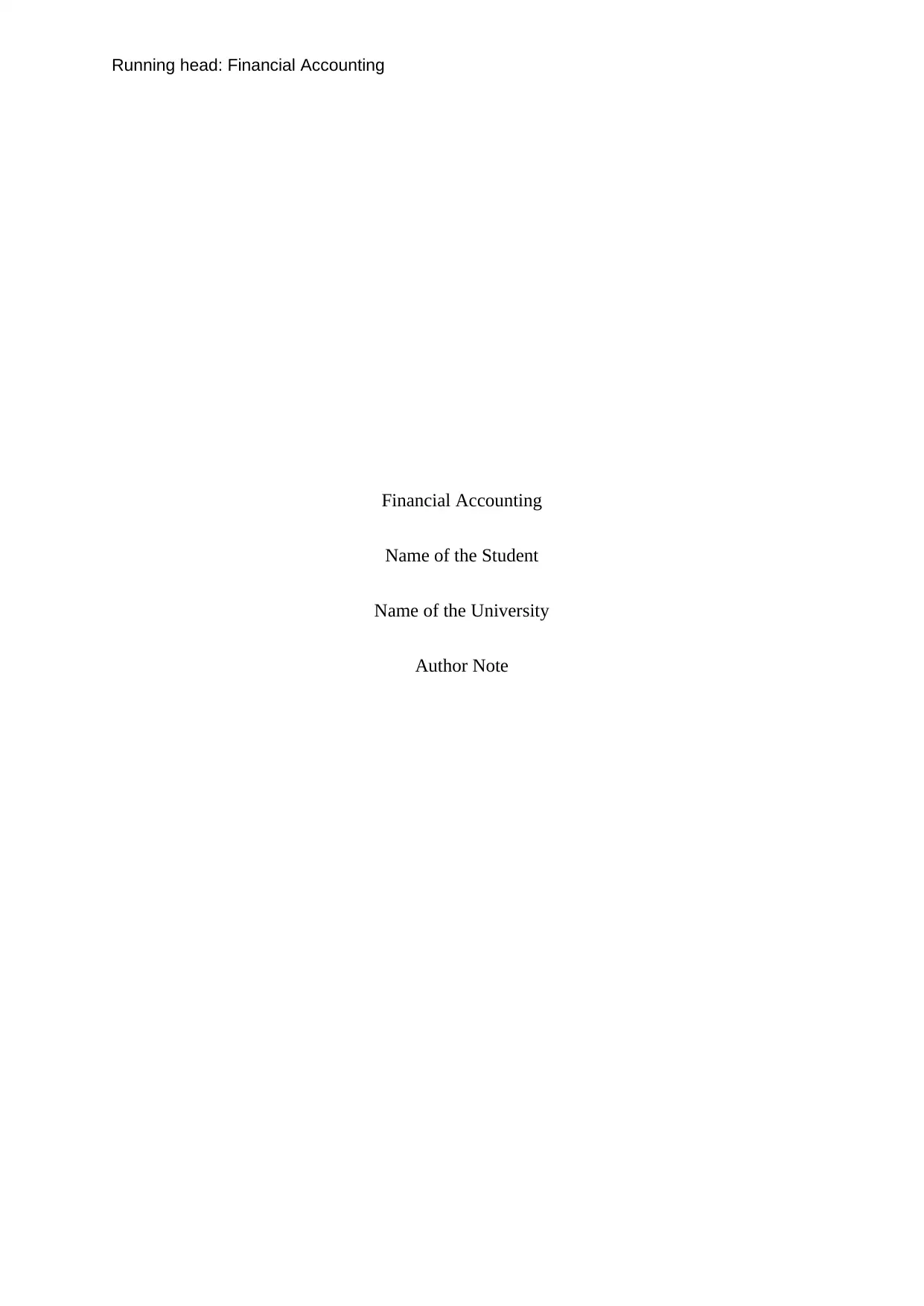
Running head: Financial Accounting
Financial Accounting
Name of the Student
Name of the University
Author Note
Financial Accounting
Name of the Student
Name of the University
Author Note
Paraphrase This Document
Need a fresh take? Get an instant paraphrase of this document with our AI Paraphraser
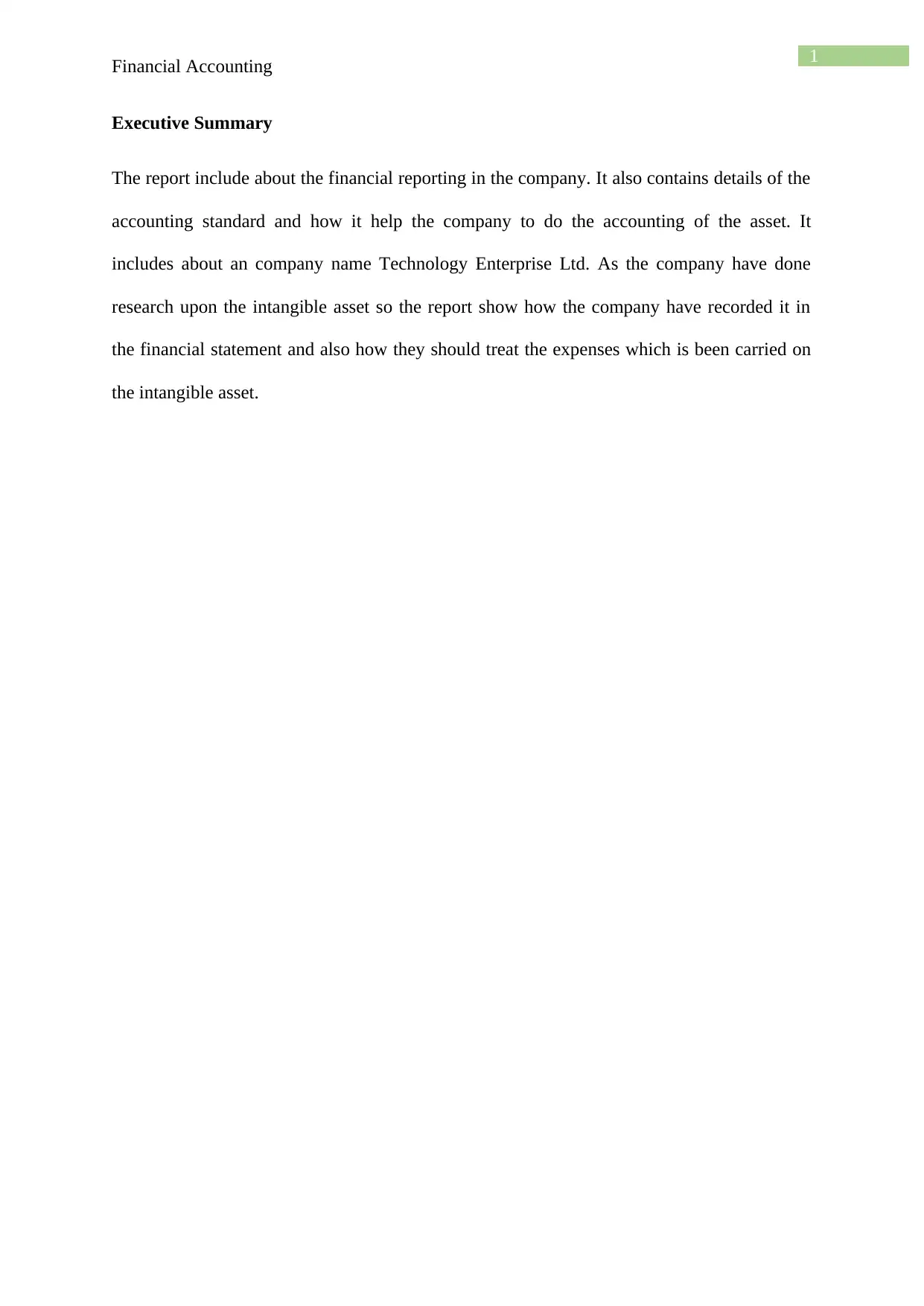
1
Financial Accounting
Executive Summary
The report include about the financial reporting in the company. It also contains details of the
accounting standard and how it help the company to do the accounting of the asset. It
includes about an company name Technology Enterprise Ltd. As the company have done
research upon the intangible asset so the report show how the company have recorded it in
the financial statement and also how they should treat the expenses which is been carried on
the intangible asset.
Financial Accounting
Executive Summary
The report include about the financial reporting in the company. It also contains details of the
accounting standard and how it help the company to do the accounting of the asset. It
includes about an company name Technology Enterprise Ltd. As the company have done
research upon the intangible asset so the report show how the company have recorded it in
the financial statement and also how they should treat the expenses which is been carried on
the intangible asset.
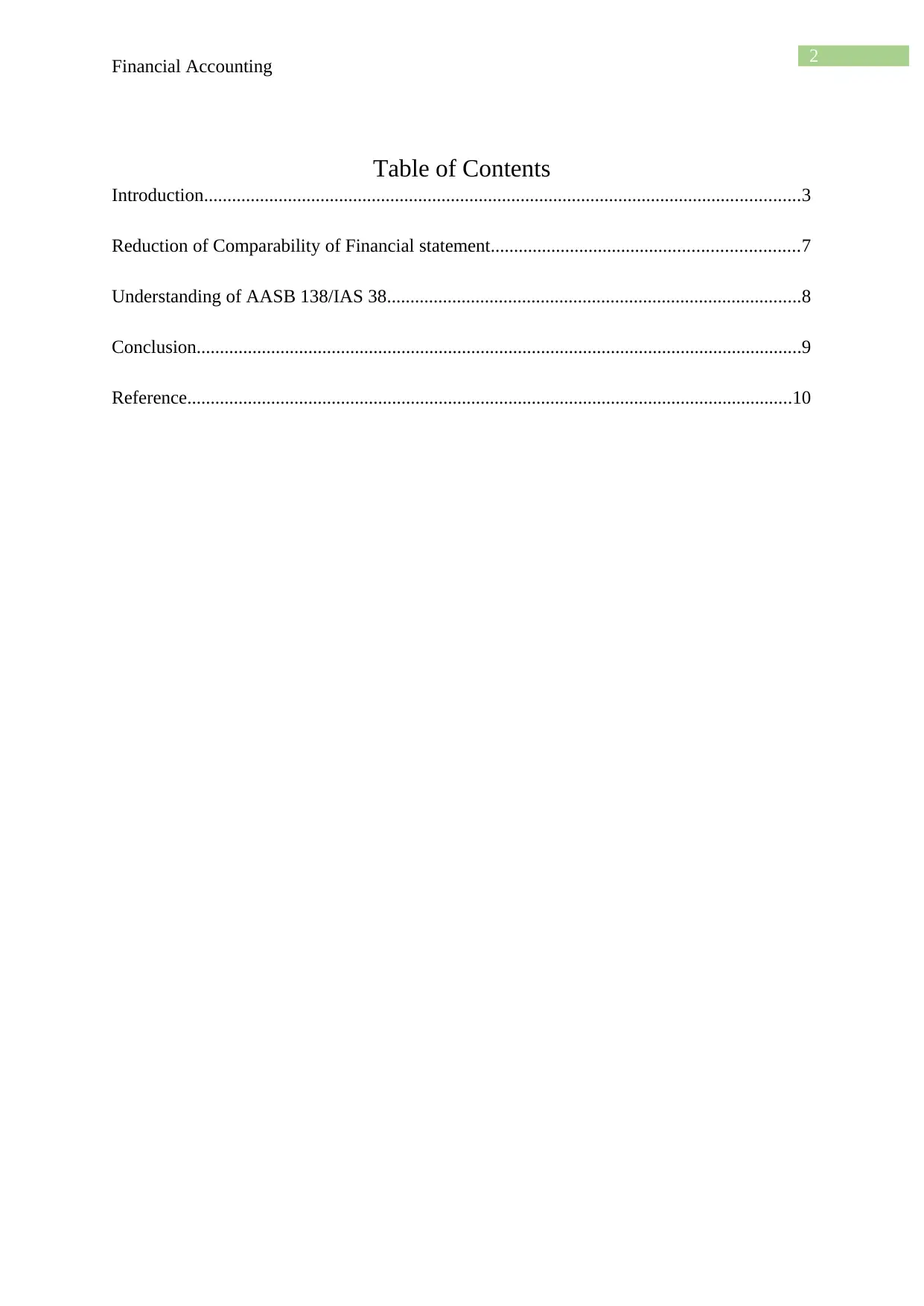
2
Financial Accounting
Table of Contents
Introduction................................................................................................................................3
Reduction of Comparability of Financial statement..................................................................7
Understanding of AASB 138/IAS 38.........................................................................................8
Conclusion..................................................................................................................................9
Reference..................................................................................................................................10
Financial Accounting
Table of Contents
Introduction................................................................................................................................3
Reduction of Comparability of Financial statement..................................................................7
Understanding of AASB 138/IAS 38.........................................................................................8
Conclusion..................................................................................................................................9
Reference..................................................................................................................................10
⊘ This is a preview!⊘
Do you want full access?
Subscribe today to unlock all pages.

Trusted by 1+ million students worldwide
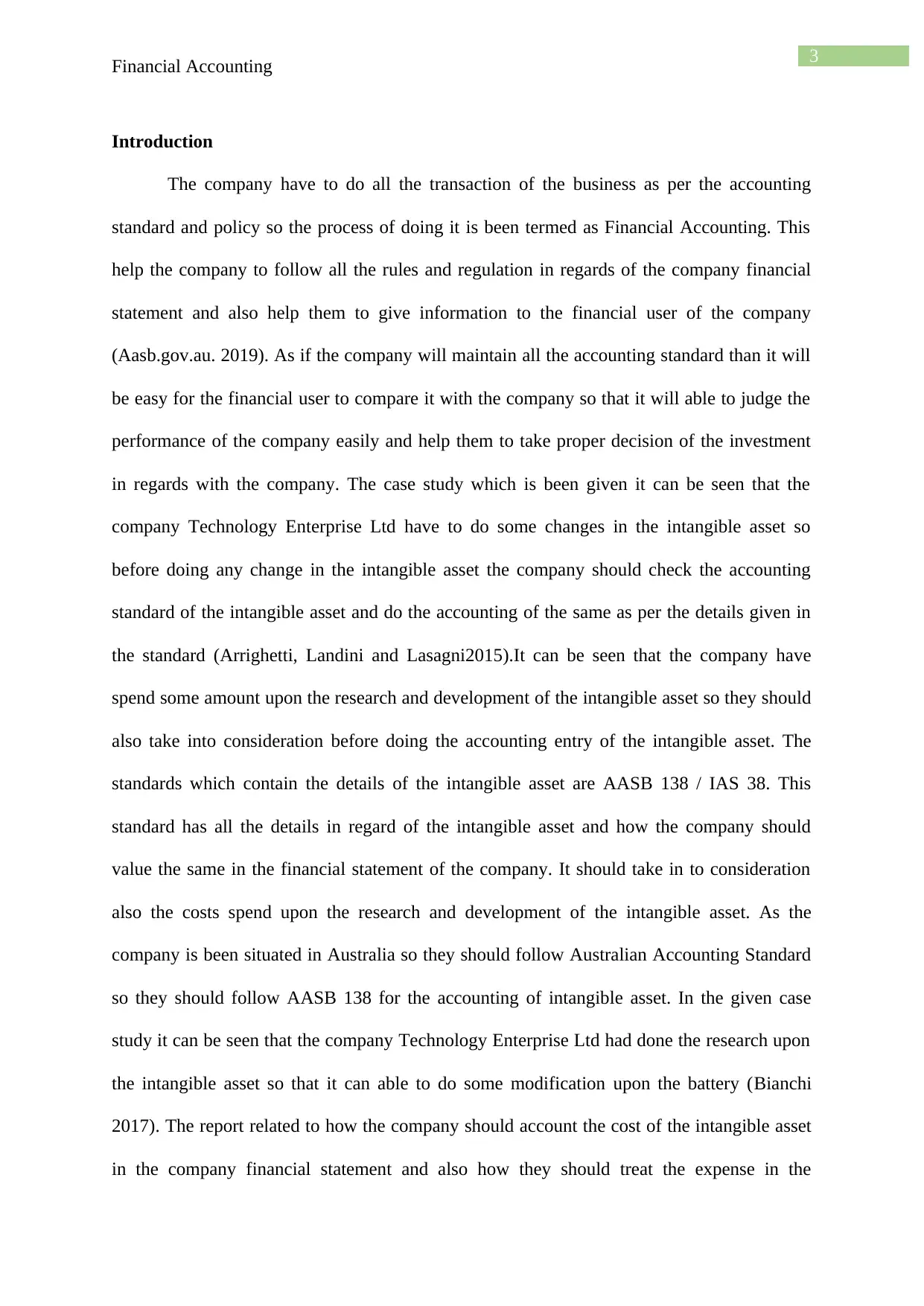
3
Financial Accounting
Introduction
The company have to do all the transaction of the business as per the accounting
standard and policy so the process of doing it is been termed as Financial Accounting. This
help the company to follow all the rules and regulation in regards of the company financial
statement and also help them to give information to the financial user of the company
(Aasb.gov.au. 2019). As if the company will maintain all the accounting standard than it will
be easy for the financial user to compare it with the company so that it will able to judge the
performance of the company easily and help them to take proper decision of the investment
in regards with the company. The case study which is been given it can be seen that the
company Technology Enterprise Ltd have to do some changes in the intangible asset so
before doing any change in the intangible asset the company should check the accounting
standard of the intangible asset and do the accounting of the same as per the details given in
the standard (Arrighetti, Landini and Lasagni2015).It can be seen that the company have
spend some amount upon the research and development of the intangible asset so they should
also take into consideration before doing the accounting entry of the intangible asset. The
standards which contain the details of the intangible asset are AASB 138 / IAS 38. This
standard has all the details in regard of the intangible asset and how the company should
value the same in the financial statement of the company. It should take in to consideration
also the costs spend upon the research and development of the intangible asset. As the
company is been situated in Australia so they should follow Australian Accounting Standard
so they should follow AASB 138 for the accounting of intangible asset. In the given case
study it can be seen that the company Technology Enterprise Ltd had done the research upon
the intangible asset so that it can able to do some modification upon the battery (Bianchi
2017). The report related to how the company should account the cost of the intangible asset
in the company financial statement and also how they should treat the expense in the
Financial Accounting
Introduction
The company have to do all the transaction of the business as per the accounting
standard and policy so the process of doing it is been termed as Financial Accounting. This
help the company to follow all the rules and regulation in regards of the company financial
statement and also help them to give information to the financial user of the company
(Aasb.gov.au. 2019). As if the company will maintain all the accounting standard than it will
be easy for the financial user to compare it with the company so that it will able to judge the
performance of the company easily and help them to take proper decision of the investment
in regards with the company. The case study which is been given it can be seen that the
company Technology Enterprise Ltd have to do some changes in the intangible asset so
before doing any change in the intangible asset the company should check the accounting
standard of the intangible asset and do the accounting of the same as per the details given in
the standard (Arrighetti, Landini and Lasagni2015).It can be seen that the company have
spend some amount upon the research and development of the intangible asset so they should
also take into consideration before doing the accounting entry of the intangible asset. The
standards which contain the details of the intangible asset are AASB 138 / IAS 38. This
standard has all the details in regard of the intangible asset and how the company should
value the same in the financial statement of the company. It should take in to consideration
also the costs spend upon the research and development of the intangible asset. As the
company is been situated in Australia so they should follow Australian Accounting Standard
so they should follow AASB 138 for the accounting of intangible asset. In the given case
study it can be seen that the company Technology Enterprise Ltd had done the research upon
the intangible asset so that it can able to do some modification upon the battery (Bianchi
2017). The report related to how the company should account the cost of the intangible asset
in the company financial statement and also how they should treat the expense in the
Paraphrase This Document
Need a fresh take? Get an instant paraphrase of this document with our AI Paraphraser
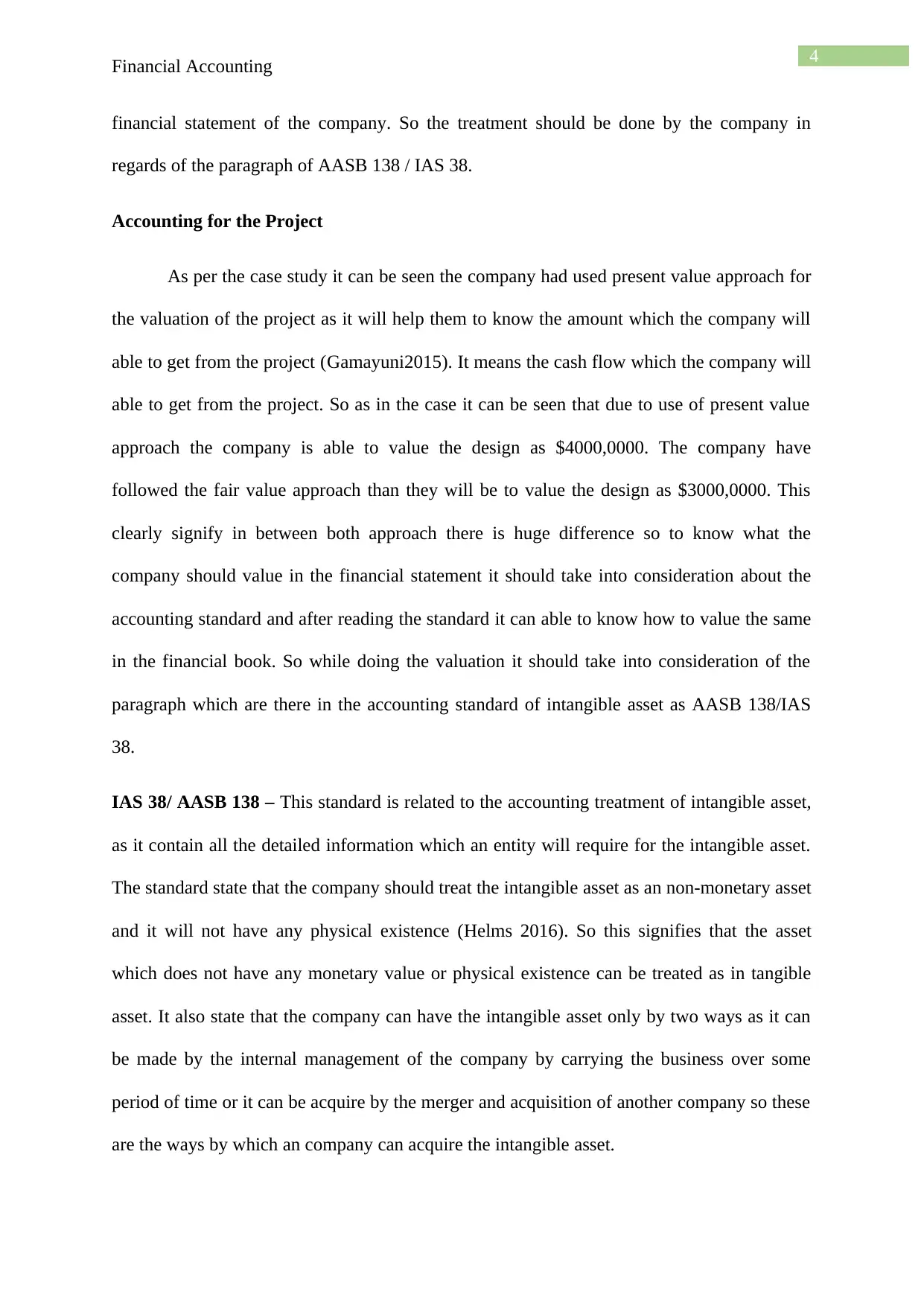
4
Financial Accounting
financial statement of the company. So the treatment should be done by the company in
regards of the paragraph of AASB 138 / IAS 38.
Accounting for the Project
As per the case study it can be seen the company had used present value approach for
the valuation of the project as it will help them to know the amount which the company will
able to get from the project (Gamayuni2015). It means the cash flow which the company will
able to get from the project. So as in the case it can be seen that due to use of present value
approach the company is able to value the design as $4000,0000. The company have
followed the fair value approach than they will be to value the design as $3000,0000. This
clearly signify in between both approach there is huge difference so to know what the
company should value in the financial statement it should take into consideration about the
accounting standard and after reading the standard it can able to know how to value the same
in the financial book. So while doing the valuation it should take into consideration of the
paragraph which are there in the accounting standard of intangible asset as AASB 138/IAS
38.
IAS 38/ AASB 138 – This standard is related to the accounting treatment of intangible asset,
as it contain all the detailed information which an entity will require for the intangible asset.
The standard state that the company should treat the intangible asset as an non-monetary asset
and it will not have any physical existence (Helms 2016). So this signifies that the asset
which does not have any monetary value or physical existence can be treated as in tangible
asset. It also state that the company can have the intangible asset only by two ways as it can
be made by the internal management of the company by carrying the business over some
period of time or it can be acquire by the merger and acquisition of another company so these
are the ways by which an company can acquire the intangible asset.
Financial Accounting
financial statement of the company. So the treatment should be done by the company in
regards of the paragraph of AASB 138 / IAS 38.
Accounting for the Project
As per the case study it can be seen the company had used present value approach for
the valuation of the project as it will help them to know the amount which the company will
able to get from the project (Gamayuni2015). It means the cash flow which the company will
able to get from the project. So as in the case it can be seen that due to use of present value
approach the company is able to value the design as $4000,0000. The company have
followed the fair value approach than they will be to value the design as $3000,0000. This
clearly signify in between both approach there is huge difference so to know what the
company should value in the financial statement it should take into consideration about the
accounting standard and after reading the standard it can able to know how to value the same
in the financial book. So while doing the valuation it should take into consideration of the
paragraph which are there in the accounting standard of intangible asset as AASB 138/IAS
38.
IAS 38/ AASB 138 – This standard is related to the accounting treatment of intangible asset,
as it contain all the detailed information which an entity will require for the intangible asset.
The standard state that the company should treat the intangible asset as an non-monetary asset
and it will not have any physical existence (Helms 2016). So this signifies that the asset
which does not have any monetary value or physical existence can be treated as in tangible
asset. It also state that the company can have the intangible asset only by two ways as it can
be made by the internal management of the company by carrying the business over some
period of time or it can be acquire by the merger and acquisition of another company so these
are the ways by which an company can acquire the intangible asset.
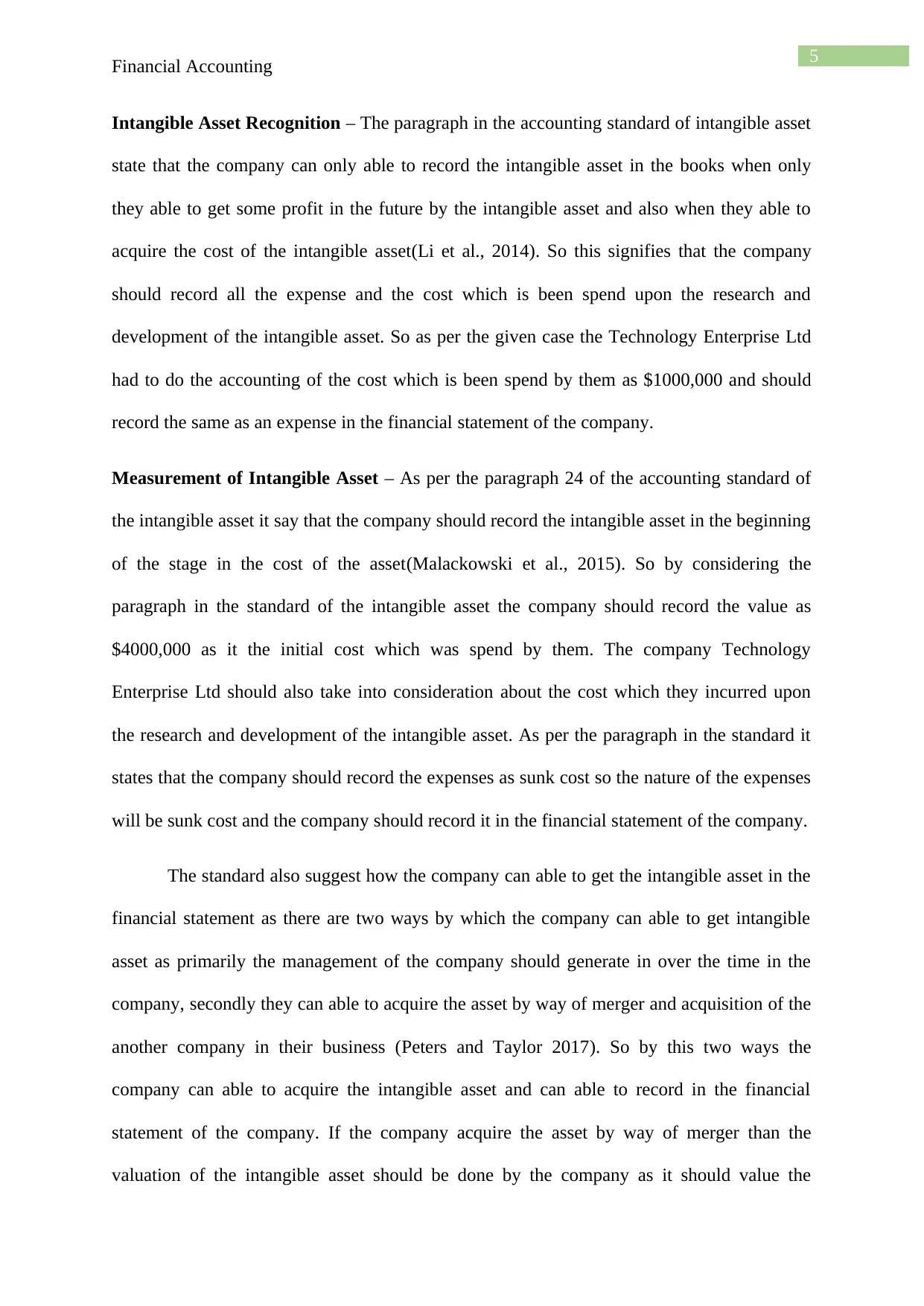
5
Financial Accounting
Intangible Asset Recognition – The paragraph in the accounting standard of intangible asset
state that the company can only able to record the intangible asset in the books when only
they able to get some profit in the future by the intangible asset and also when they able to
acquire the cost of the intangible asset(Li et al., 2014). So this signifies that the company
should record all the expense and the cost which is been spend upon the research and
development of the intangible asset. So as per the given case the Technology Enterprise Ltd
had to do the accounting of the cost which is been spend by them as $1000,000 and should
record the same as an expense in the financial statement of the company.
Measurement of Intangible Asset – As per the paragraph 24 of the accounting standard of
the intangible asset it say that the company should record the intangible asset in the beginning
of the stage in the cost of the asset(Malackowski et al., 2015). So by considering the
paragraph in the standard of the intangible asset the company should record the value as
$4000,000 as it the initial cost which was spend by them. The company Technology
Enterprise Ltd should also take into consideration about the cost which they incurred upon
the research and development of the intangible asset. As per the paragraph in the standard it
states that the company should record the expenses as sunk cost so the nature of the expenses
will be sunk cost and the company should record it in the financial statement of the company.
The standard also suggest how the company can able to get the intangible asset in the
financial statement as there are two ways by which the company can able to get intangible
asset as primarily the management of the company should generate in over the time in the
company, secondly they can able to acquire the asset by way of merger and acquisition of the
another company in their business (Peters and Taylor 2017). So by this two ways the
company can able to acquire the intangible asset and can able to record in the financial
statement of the company. If the company acquire the asset by way of merger than the
valuation of the intangible asset should be done by the company as it should value the
Financial Accounting
Intangible Asset Recognition – The paragraph in the accounting standard of intangible asset
state that the company can only able to record the intangible asset in the books when only
they able to get some profit in the future by the intangible asset and also when they able to
acquire the cost of the intangible asset(Li et al., 2014). So this signifies that the company
should record all the expense and the cost which is been spend upon the research and
development of the intangible asset. So as per the given case the Technology Enterprise Ltd
had to do the accounting of the cost which is been spend by them as $1000,000 and should
record the same as an expense in the financial statement of the company.
Measurement of Intangible Asset – As per the paragraph 24 of the accounting standard of
the intangible asset it say that the company should record the intangible asset in the beginning
of the stage in the cost of the asset(Malackowski et al., 2015). So by considering the
paragraph in the standard of the intangible asset the company should record the value as
$4000,000 as it the initial cost which was spend by them. The company Technology
Enterprise Ltd should also take into consideration about the cost which they incurred upon
the research and development of the intangible asset. As per the paragraph in the standard it
states that the company should record the expenses as sunk cost so the nature of the expenses
will be sunk cost and the company should record it in the financial statement of the company.
The standard also suggest how the company can able to get the intangible asset in the
financial statement as there are two ways by which the company can able to get intangible
asset as primarily the management of the company should generate in over the time in the
company, secondly they can able to acquire the asset by way of merger and acquisition of the
another company in their business (Peters and Taylor 2017). So by this two ways the
company can able to acquire the intangible asset and can able to record in the financial
statement of the company. If the company acquire the asset by way of merger than the
valuation of the intangible asset should be done by the company as it should value the
⊘ This is a preview!⊘
Do you want full access?
Subscribe today to unlock all pages.

Trusted by 1+ million students worldwide
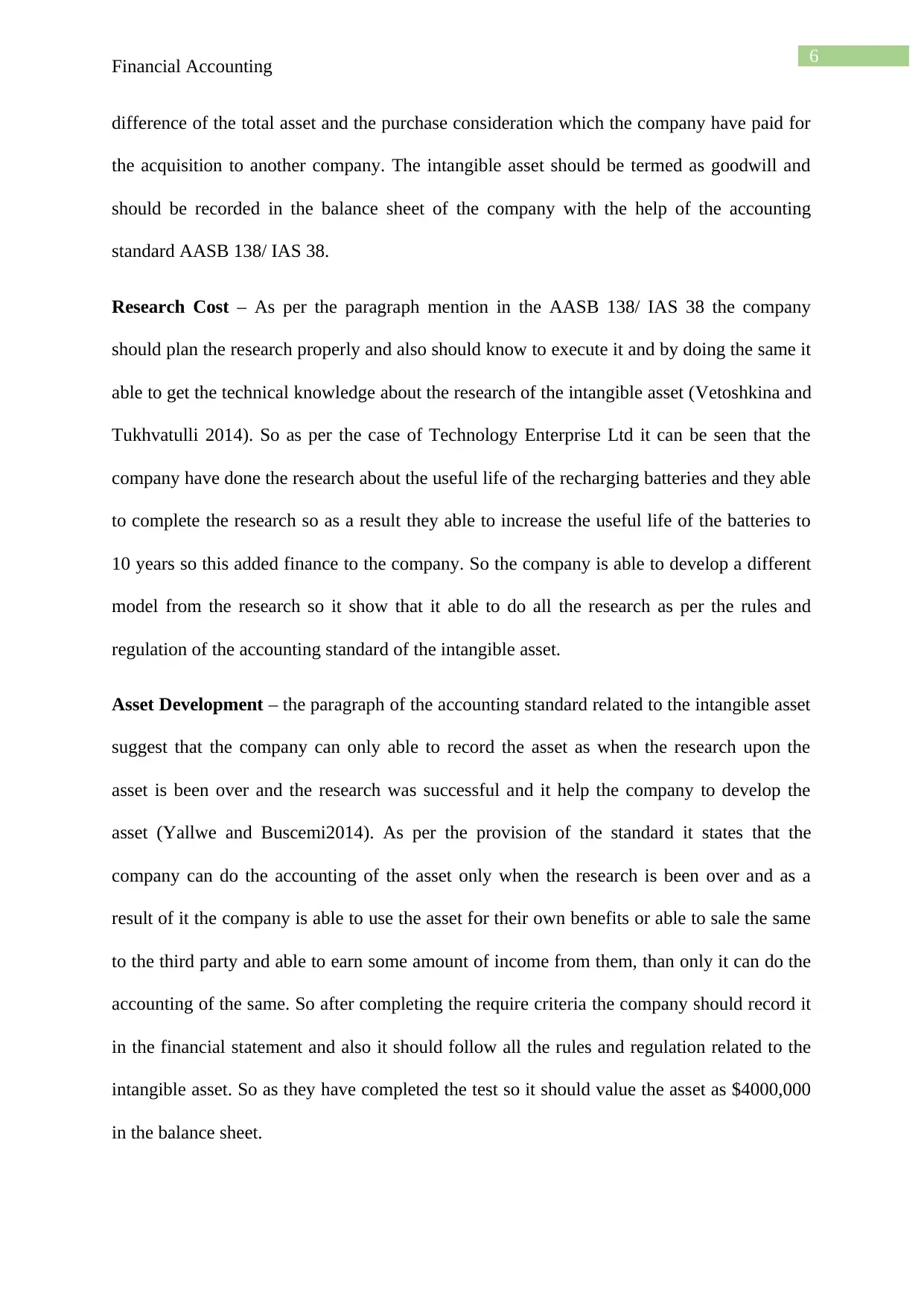
6
Financial Accounting
difference of the total asset and the purchase consideration which the company have paid for
the acquisition to another company. The intangible asset should be termed as goodwill and
should be recorded in the balance sheet of the company with the help of the accounting
standard AASB 138/ IAS 38.
Research Cost – As per the paragraph mention in the AASB 138/ IAS 38 the company
should plan the research properly and also should know to execute it and by doing the same it
able to get the technical knowledge about the research of the intangible asset (Vetoshkina and
Tukhvatulli 2014). So as per the case of Technology Enterprise Ltd it can be seen that the
company have done the research about the useful life of the recharging batteries and they able
to complete the research so as a result they able to increase the useful life of the batteries to
10 years so this added finance to the company. So the company is able to develop a different
model from the research so it show that it able to do all the research as per the rules and
regulation of the accounting standard of the intangible asset.
Asset Development – the paragraph of the accounting standard related to the intangible asset
suggest that the company can only able to record the asset as when the research upon the
asset is been over and the research was successful and it help the company to develop the
asset (Yallwe and Buscemi2014). As per the provision of the standard it states that the
company can do the accounting of the asset only when the research is been over and as a
result of it the company is able to use the asset for their own benefits or able to sale the same
to the third party and able to earn some amount of income from them, than only it can do the
accounting of the same. So after completing the require criteria the company should record it
in the financial statement and also it should follow all the rules and regulation related to the
intangible asset. So as they have completed the test so it should value the asset as $4000,000
in the balance sheet.
Financial Accounting
difference of the total asset and the purchase consideration which the company have paid for
the acquisition to another company. The intangible asset should be termed as goodwill and
should be recorded in the balance sheet of the company with the help of the accounting
standard AASB 138/ IAS 38.
Research Cost – As per the paragraph mention in the AASB 138/ IAS 38 the company
should plan the research properly and also should know to execute it and by doing the same it
able to get the technical knowledge about the research of the intangible asset (Vetoshkina and
Tukhvatulli 2014). So as per the case of Technology Enterprise Ltd it can be seen that the
company have done the research about the useful life of the recharging batteries and they able
to complete the research so as a result they able to increase the useful life of the batteries to
10 years so this added finance to the company. So the company is able to develop a different
model from the research so it show that it able to do all the research as per the rules and
regulation of the accounting standard of the intangible asset.
Asset Development – the paragraph of the accounting standard related to the intangible asset
suggest that the company can only able to record the asset as when the research upon the
asset is been over and the research was successful and it help the company to develop the
asset (Yallwe and Buscemi2014). As per the provision of the standard it states that the
company can do the accounting of the asset only when the research is been over and as a
result of it the company is able to use the asset for their own benefits or able to sale the same
to the third party and able to earn some amount of income from them, than only it can do the
accounting of the same. So after completing the require criteria the company should record it
in the financial statement and also it should follow all the rules and regulation related to the
intangible asset. So as they have completed the test so it should value the asset as $4000,000
in the balance sheet.
Paraphrase This Document
Need a fresh take? Get an instant paraphrase of this document with our AI Paraphraser
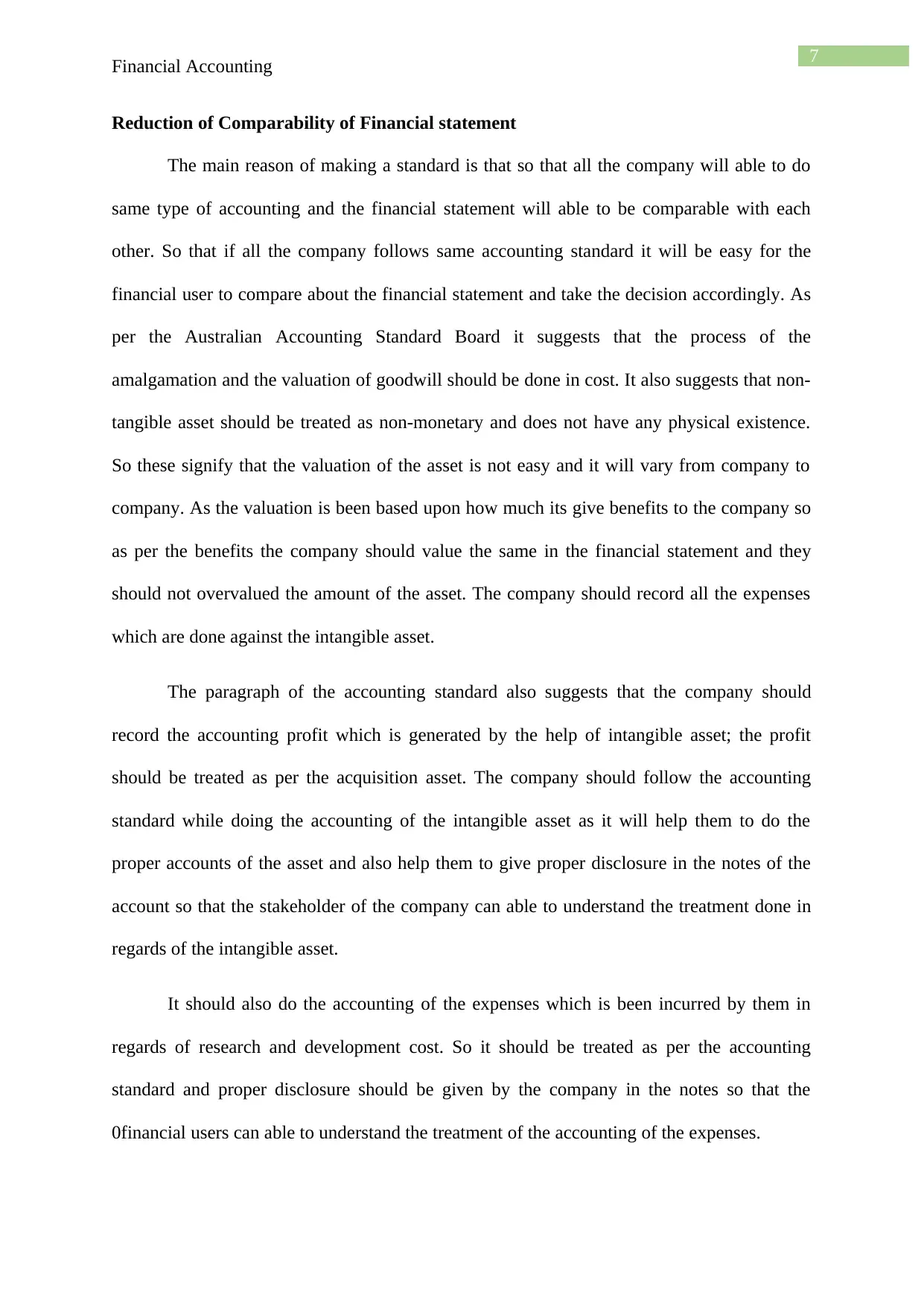
7
Financial Accounting
Reduction of Comparability of Financial statement
The main reason of making a standard is that so that all the company will able to do
same type of accounting and the financial statement will able to be comparable with each
other. So that if all the company follows same accounting standard it will be easy for the
financial user to compare about the financial statement and take the decision accordingly. As
per the Australian Accounting Standard Board it suggests that the process of the
amalgamation and the valuation of goodwill should be done in cost. It also suggests that non-
tangible asset should be treated as non-monetary and does not have any physical existence.
So these signify that the valuation of the asset is not easy and it will vary from company to
company. As the valuation is been based upon how much its give benefits to the company so
as per the benefits the company should value the same in the financial statement and they
should not overvalued the amount of the asset. The company should record all the expenses
which are done against the intangible asset.
The paragraph of the accounting standard also suggests that the company should
record the accounting profit which is generated by the help of intangible asset; the profit
should be treated as per the acquisition asset. The company should follow the accounting
standard while doing the accounting of the intangible asset as it will help them to do the
proper accounts of the asset and also help them to give proper disclosure in the notes of the
account so that the stakeholder of the company can able to understand the treatment done in
regards of the intangible asset.
It should also do the accounting of the expenses which is been incurred by them in
regards of research and development cost. So it should be treated as per the accounting
standard and proper disclosure should be given by the company in the notes so that the
0financial users can able to understand the treatment of the accounting of the expenses.
Financial Accounting
Reduction of Comparability of Financial statement
The main reason of making a standard is that so that all the company will able to do
same type of accounting and the financial statement will able to be comparable with each
other. So that if all the company follows same accounting standard it will be easy for the
financial user to compare about the financial statement and take the decision accordingly. As
per the Australian Accounting Standard Board it suggests that the process of the
amalgamation and the valuation of goodwill should be done in cost. It also suggests that non-
tangible asset should be treated as non-monetary and does not have any physical existence.
So these signify that the valuation of the asset is not easy and it will vary from company to
company. As the valuation is been based upon how much its give benefits to the company so
as per the benefits the company should value the same in the financial statement and they
should not overvalued the amount of the asset. The company should record all the expenses
which are done against the intangible asset.
The paragraph of the accounting standard also suggests that the company should
record the accounting profit which is generated by the help of intangible asset; the profit
should be treated as per the acquisition asset. The company should follow the accounting
standard while doing the accounting of the intangible asset as it will help them to do the
proper accounts of the asset and also help them to give proper disclosure in the notes of the
account so that the stakeholder of the company can able to understand the treatment done in
regards of the intangible asset.
It should also do the accounting of the expenses which is been incurred by them in
regards of research and development cost. So it should be treated as per the accounting
standard and proper disclosure should be given by the company in the notes so that the
0financial users can able to understand the treatment of the accounting of the expenses.
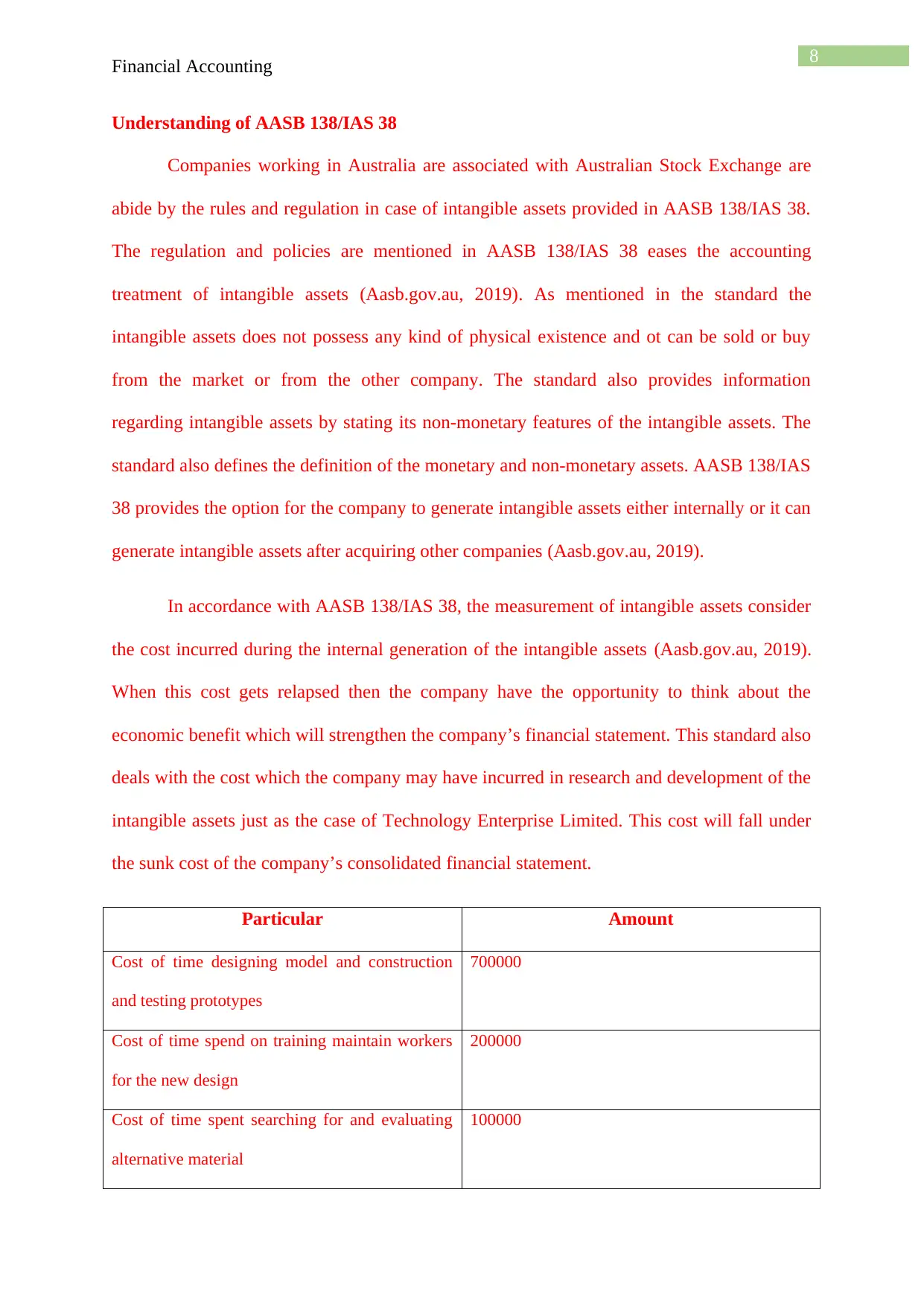
8
Financial Accounting
Understanding of AASB 138/IAS 38
Companies working in Australia are associated with Australian Stock Exchange are
abide by the rules and regulation in case of intangible assets provided in AASB 138/IAS 38.
The regulation and policies are mentioned in AASB 138/IAS 38 eases the accounting
treatment of intangible assets (Aasb.gov.au, 2019). As mentioned in the standard the
intangible assets does not possess any kind of physical existence and ot can be sold or buy
from the market or from the other company. The standard also provides information
regarding intangible assets by stating its non-monetary features of the intangible assets. The
standard also defines the definition of the monetary and non-monetary assets. AASB 138/IAS
38 provides the option for the company to generate intangible assets either internally or it can
generate intangible assets after acquiring other companies (Aasb.gov.au, 2019).
In accordance with AASB 138/IAS 38, the measurement of intangible assets consider
the cost incurred during the internal generation of the intangible assets (Aasb.gov.au, 2019).
When this cost gets relapsed then the company have the opportunity to think about the
economic benefit which will strengthen the company’s financial statement. This standard also
deals with the cost which the company may have incurred in research and development of the
intangible assets just as the case of Technology Enterprise Limited. This cost will fall under
the sunk cost of the company’s consolidated financial statement.
Particular Amount
Cost of time designing model and construction
and testing prototypes
700000
Cost of time spend on training maintain workers
for the new design
200000
Cost of time spent searching for and evaluating
alternative material
100000
Financial Accounting
Understanding of AASB 138/IAS 38
Companies working in Australia are associated with Australian Stock Exchange are
abide by the rules and regulation in case of intangible assets provided in AASB 138/IAS 38.
The regulation and policies are mentioned in AASB 138/IAS 38 eases the accounting
treatment of intangible assets (Aasb.gov.au, 2019). As mentioned in the standard the
intangible assets does not possess any kind of physical existence and ot can be sold or buy
from the market or from the other company. The standard also provides information
regarding intangible assets by stating its non-monetary features of the intangible assets. The
standard also defines the definition of the monetary and non-monetary assets. AASB 138/IAS
38 provides the option for the company to generate intangible assets either internally or it can
generate intangible assets after acquiring other companies (Aasb.gov.au, 2019).
In accordance with AASB 138/IAS 38, the measurement of intangible assets consider
the cost incurred during the internal generation of the intangible assets (Aasb.gov.au, 2019).
When this cost gets relapsed then the company have the opportunity to think about the
economic benefit which will strengthen the company’s financial statement. This standard also
deals with the cost which the company may have incurred in research and development of the
intangible assets just as the case of Technology Enterprise Limited. This cost will fall under
the sunk cost of the company’s consolidated financial statement.
Particular Amount
Cost of time designing model and construction
and testing prototypes
700000
Cost of time spend on training maintain workers
for the new design
200000
Cost of time spent searching for and evaluating
alternative material
100000
⊘ This is a preview!⊘
Do you want full access?
Subscribe today to unlock all pages.

Trusted by 1+ million students worldwide
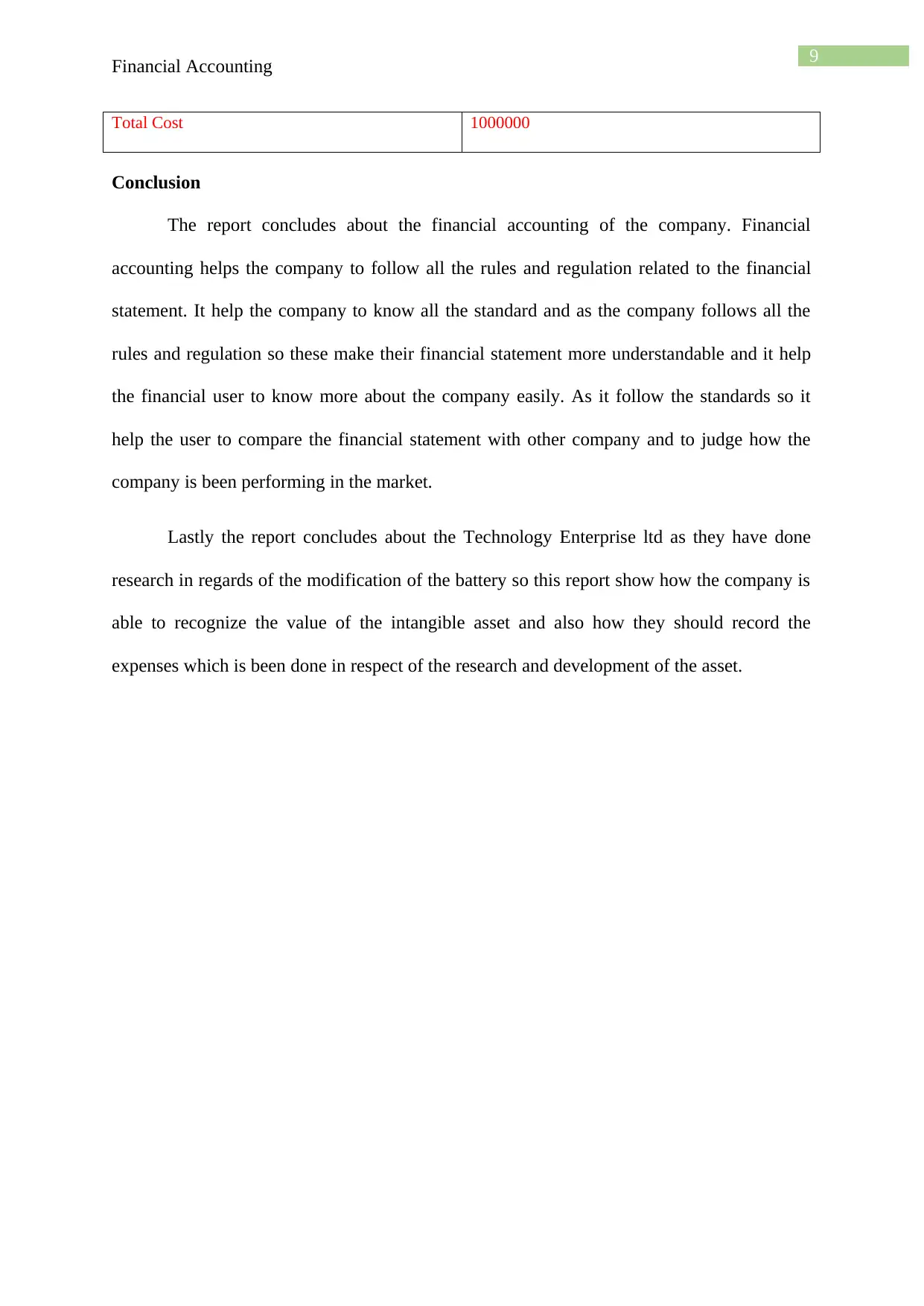
9
Financial Accounting
Total Cost 1000000
Conclusion
The report concludes about the financial accounting of the company. Financial
accounting helps the company to follow all the rules and regulation related to the financial
statement. It help the company to know all the standard and as the company follows all the
rules and regulation so these make their financial statement more understandable and it help
the financial user to know more about the company easily. As it follow the standards so it
help the user to compare the financial statement with other company and to judge how the
company is been performing in the market.
Lastly the report concludes about the Technology Enterprise ltd as they have done
research in regards of the modification of the battery so this report show how the company is
able to recognize the value of the intangible asset and also how they should record the
expenses which is been done in respect of the research and development of the asset.
Financial Accounting
Total Cost 1000000
Conclusion
The report concludes about the financial accounting of the company. Financial
accounting helps the company to follow all the rules and regulation related to the financial
statement. It help the company to know all the standard and as the company follows all the
rules and regulation so these make their financial statement more understandable and it help
the financial user to know more about the company easily. As it follow the standards so it
help the user to compare the financial statement with other company and to judge how the
company is been performing in the market.
Lastly the report concludes about the Technology Enterprise ltd as they have done
research in regards of the modification of the battery so this report show how the company is
able to recognize the value of the intangible asset and also how they should record the
expenses which is been done in respect of the research and development of the asset.
Paraphrase This Document
Need a fresh take? Get an instant paraphrase of this document with our AI Paraphraser
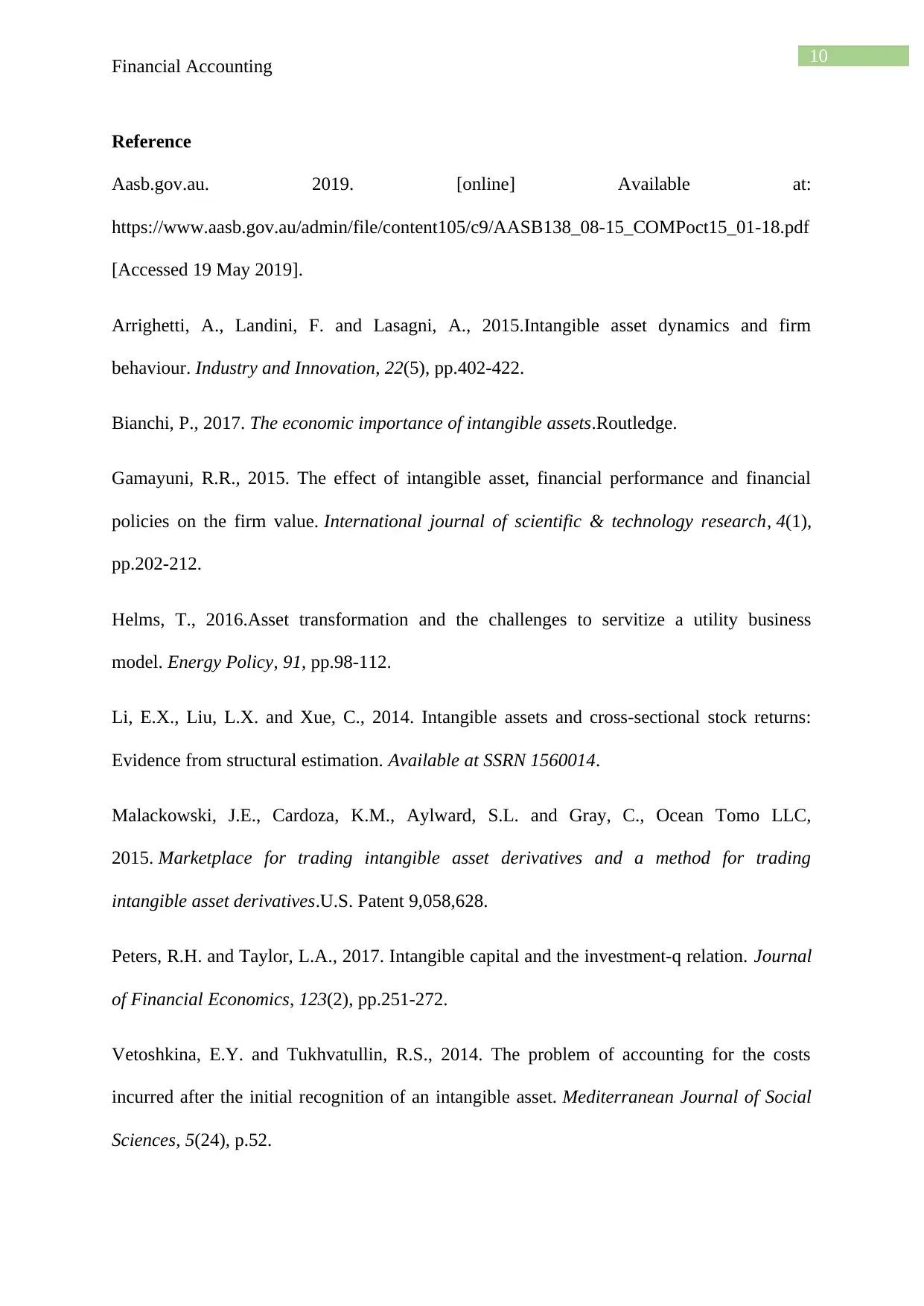
10
Financial Accounting
Reference
Aasb.gov.au. 2019. [online] Available at:
https://www.aasb.gov.au/admin/file/content105/c9/AASB138_08-15_COMPoct15_01-18.pdf
[Accessed 19 May 2019].
Arrighetti, A., Landini, F. and Lasagni, A., 2015.Intangible asset dynamics and firm
behaviour. Industry and Innovation, 22(5), pp.402-422.
Bianchi, P., 2017. The economic importance of intangible assets.Routledge.
Gamayuni, R.R., 2015. The effect of intangible asset, financial performance and financial
policies on the firm value. International journal of scientific & technology research, 4(1),
pp.202-212.
Helms, T., 2016.Asset transformation and the challenges to servitize a utility business
model. Energy Policy, 91, pp.98-112.
Li, E.X., Liu, L.X. and Xue, C., 2014. Intangible assets and cross-sectional stock returns:
Evidence from structural estimation. Available at SSRN 1560014.
Malackowski, J.E., Cardoza, K.M., Aylward, S.L. and Gray, C., Ocean Tomo LLC,
2015. Marketplace for trading intangible asset derivatives and a method for trading
intangible asset derivatives.U.S. Patent 9,058,628.
Peters, R.H. and Taylor, L.A., 2017. Intangible capital and the investment-q relation. Journal
of Financial Economics, 123(2), pp.251-272.
Vetoshkina, E.Y. and Tukhvatullin, R.S., 2014. The problem of accounting for the costs
incurred after the initial recognition of an intangible asset. Mediterranean Journal of Social
Sciences, 5(24), p.52.
Financial Accounting
Reference
Aasb.gov.au. 2019. [online] Available at:
https://www.aasb.gov.au/admin/file/content105/c9/AASB138_08-15_COMPoct15_01-18.pdf
[Accessed 19 May 2019].
Arrighetti, A., Landini, F. and Lasagni, A., 2015.Intangible asset dynamics and firm
behaviour. Industry and Innovation, 22(5), pp.402-422.
Bianchi, P., 2017. The economic importance of intangible assets.Routledge.
Gamayuni, R.R., 2015. The effect of intangible asset, financial performance and financial
policies on the firm value. International journal of scientific & technology research, 4(1),
pp.202-212.
Helms, T., 2016.Asset transformation and the challenges to servitize a utility business
model. Energy Policy, 91, pp.98-112.
Li, E.X., Liu, L.X. and Xue, C., 2014. Intangible assets and cross-sectional stock returns:
Evidence from structural estimation. Available at SSRN 1560014.
Malackowski, J.E., Cardoza, K.M., Aylward, S.L. and Gray, C., Ocean Tomo LLC,
2015. Marketplace for trading intangible asset derivatives and a method for trading
intangible asset derivatives.U.S. Patent 9,058,628.
Peters, R.H. and Taylor, L.A., 2017. Intangible capital and the investment-q relation. Journal
of Financial Economics, 123(2), pp.251-272.
Vetoshkina, E.Y. and Tukhvatullin, R.S., 2014. The problem of accounting for the costs
incurred after the initial recognition of an intangible asset. Mediterranean Journal of Social
Sciences, 5(24), p.52.
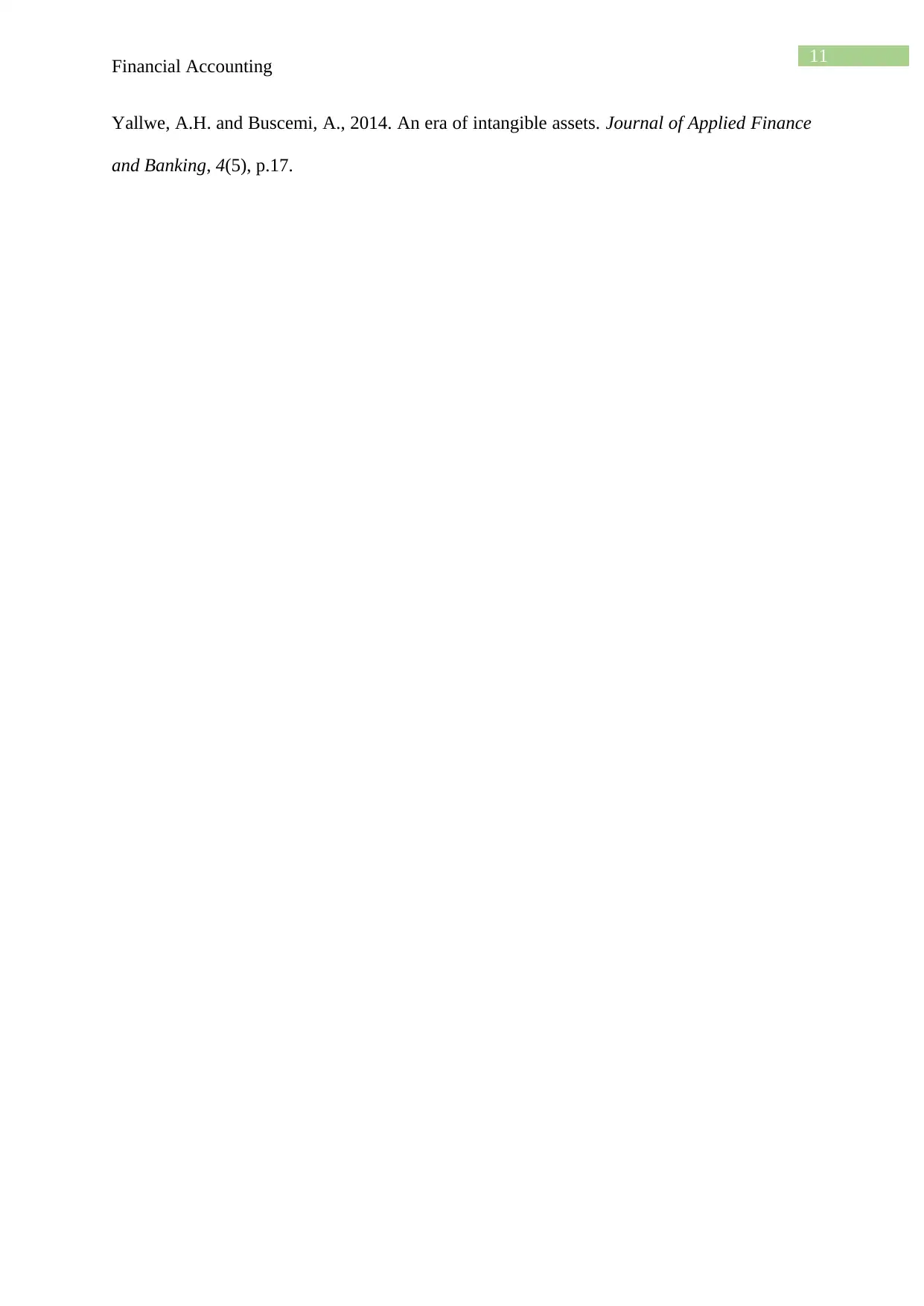
11
Financial Accounting
Yallwe, A.H. and Buscemi, A., 2014. An era of intangible assets. Journal of Applied Finance
and Banking, 4(5), p.17.
Financial Accounting
Yallwe, A.H. and Buscemi, A., 2014. An era of intangible assets. Journal of Applied Finance
and Banking, 4(5), p.17.
⊘ This is a preview!⊘
Do you want full access?
Subscribe today to unlock all pages.

Trusted by 1+ million students worldwide
1 out of 12
Related Documents
Your All-in-One AI-Powered Toolkit for Academic Success.
+13062052269
info@desklib.com
Available 24*7 on WhatsApp / Email
![[object Object]](/_next/static/media/star-bottom.7253800d.svg)
Unlock your academic potential
Copyright © 2020–2025 A2Z Services. All Rights Reserved. Developed and managed by ZUCOL.





